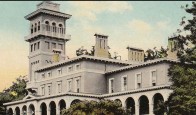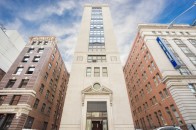A trend is growing in the Baltimore area. Buildings that were once or are currently intended to serve the Baltimore community in some capacity, whether to serve as the home of Baltimore’s urban service corps, provide low-income housing in a revitalizing community, or having once housed Baltimore’s City Hall, are now also pursuing a green building path in order to also serve the environment.
Clifton Mansion
Clifton Mansion, expected to achieve LEED Gold certification by November 20, 2015, is the home of Civic Works, Baltimore’s urban service corps and an AmeriCorps program. Civic Works builds brighter futures by placing participants in job training opportunities and provides service experience for volunteers, particularly in weatherization, construction, and healthcare industries. Civic Works is also committed to creating a more sustainable, economically viable, environmentally responsible agriculture sector in Baltimore by producing fresh produce and planting trees. Their programs provide a pathway out of poverty, while making a positive impact on the environment by making home energy improvements, repairing homes, and securing living wage employment for those who complete the program.
Clifton Mansion, originally built between 1790 and 1801 by Henry Thompson, Captain of the Fly Artillery, 3rd Maryland Brigade in the War of 1812, was later purchased by philanthropist Johns Hopkins to serve as his summer residence. The City of Baltimore later bought the property in 1895 from Johns Hopkins University and has served many purposes since. Its new roof, rainwater-removal system, geothermal heat pumps, and efficient HVAC system, as well as specialized restoration techniques to recover original finishes, have all improved and repaired the building from the many different uses over the last several decades.
For Clifton Mansion, achieving LEED certification is not only a means to important funding opportunities, but is mission critical to the organization it houses.
CHAI Fallstaff Apartments
CHAI Fallstaff Apartments is a multi-family residential building pursuing the Baltimore City Green Building Standard Two Star Rating, as well as the Enterprise Green Communities certification – the first green building rating system in the nation to address the unique needs of the affordable housing sector. The Comprehensive Housing Assistance, Inc (CHAI) organization, a non-profit committed to developing and supporting thriving, stable communities in neighborhoods with a substantial Jewish population, is coordinating a moderate renovation of Fallstaff Apartments in the Park Heights neighborhood of Baltimore.
The project, a 3 story multi-family apartment renovation with 16 units, is intended to house low income residents. With 14 units provided at a low income rate and two at market rate, the Fallstaff Apartments project will secure 1 unit for a formerly homeless family, 2 units for non-elderly disabled (NED) residents from Baltimore City’s NED list, 1 unit for a family from Baltimore City Bailey Uniform Federal Accessibility Standards (UFAS) list, and 1 unit designed for a family needing UFAS.
This moderate rehab supports CHAI’s mission to increase economic stability in northwest Baltimore, strengthens neighborhood safety and community, and serves the needs of low-income residents. The project team is installing a new roof, more efficient windows, better insulation in the roof cavity, CFL lighting, low-flow water fixtures, energy efficient heating and cooling systems, as well as Energy Star Appliances in each unit. In the case of Fallstaff Apartments, the sustainable strategies and technologies implemented on the project help to keep utility costs low and living conditions healthy for residents with the highest need.
26 S Calvert Street
Just a couple of blocks from the Inner Harbor, 26 S Calvert Street, the historic limestone-clad former United States Fidelity and Guaranty Company (USF&G) building has been converted into an 85 unit residential building pursuing Baltimore City Green Building Standard Two Star certification. Originally built in 1928, USF&G inhabited the building until 1970. A few years later, in 1974, when the City of Baltimore voted to renovate the old City Hall building, operations of the city were moved to 26 S Calvert Street for two years while the original city hall went under extensive renovations. During the years City Hall took up residence in 26 S Calvert Street, Mayor William Donald Schaefer was the incumbent Baltimore City Mayor, serving the city of Baltimore. Unfortunately, an attempted attack on Mayor Schaefer by a crazed and disgruntled local businessman took place on April 13, 1976 in the temporary City Hall. Luckily, Mayor Schaefer survived the attach, however; a councilman was not as fortunate.
After the Mayoral office moved back to City Hall, the building sat empty for several years until PMC Properties bought it from the city, along with neighboring properties, in early 2014. PMC properties has preserved the historic character of the building, while also making it appealing to the growing population of millennials in Baltimore City. The apartments feature soaring views of the harbor, modern kitchens, high-efficiency HVAC systems, a fully-equipped fitness center, bike storage and maintenance facility, lounge and work stations, a game and entertainment center, and walkable amenities.
The apartments at 26 S Calvert Street have seamlessly integrated sustainability, adaptive reuse, local history, service to the community, and innovation into a multi-family residence that appeals to a large market.
.



